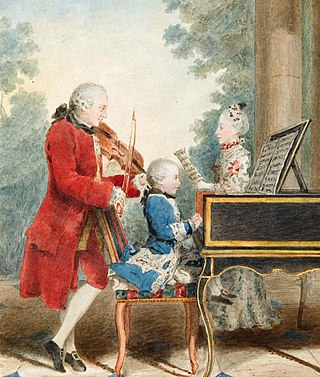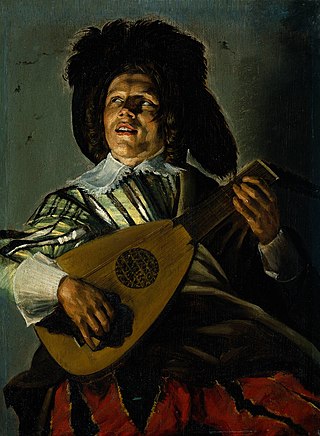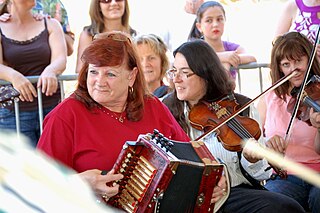
The Classical Period was an era of classical music between roughly 1750 and 1820.

An orchestra is a large instrumental ensemble typical of classical music, which combines instruments from different families. There are typically four main sections of instruments:

Chamber music is a form of classical music that is composed for a small group of instruments—traditionally a group that could fit in a palace chamber or a large room. Most broadly, it includes any art music that is performed by a small number of performers, with one performer to a part. However, by convention, it usually does not include solo instrument performances.

A concert is a live music performance in front of an audience. The performance may be carried by a single musician, sometimes then called a recital, or by a musical ensemble, such as an orchestra, choir, or band. Concerts are held in a wide variety and size of settings, from private houses and small nightclubs, dedicated concert halls, amphitheatres and parks, to large multipurpose buildings, such as arenas and stadiums. Indoor concerts held in the largest venues are sometimes called arena concerts or amphitheatre concerts. Informal names for a concert include show and gig.

A piano concerto, a type of concerto, is a solo composition in the classical music genre which is composed for piano accompanied by an orchestra or other large ensemble. Piano concertos are typically virtuosic showpieces which require an advanced level of technique. Piano concertos are typically written out in music notation, including sheet music for the pianist, orchestral parts, and a full score for the conductor.

The Macedonian music refers to all forms of music associated with ethnic Macedonians. It shares similarities with the music of neighbouring Balkan countries, yet it remains overall distinctive in its rhythm and sound.

Applause is primarily a form of ovation or praise expressed by the act of clapping, or striking the palms of the hands together, in order to create noise. Audiences usually applaud after a performance, such as a musical concert, speech, or play, as a sign of enjoyment and approval.
In Western classical music, obbligato usually describes a musical line that is in some way indispensable in performance. Its opposite is the marking ad libitum. It can also be used, more specifically, to indicate that a passage of music was to be played exactly as written, or only by the specified instrument, without changes or omissions. The word is borrowed from Italian ; the spelling obligato is not acceptable in British English, but it is often used as an alternative spelling in the US. The word can stand on its own, in English, as a noun, or appear as a modifier in a noun phrase.
In music, variation is a formal technique where material is repeated in an altered form. The changes may involve melody, rhythm, harmony, counterpoint, timbre, orchestration or any combination of these.

A clap is the percussive sound made by striking together two flat surfaces, as in the body parts of humans or animals. Humans clap with the palms of their hands, often quickly and repeatedly to express appreciation or approval, but also in rhythm as a form of body percussion to match the sounds in music, dance, chants, hand games, and clapping games.

In music, a serenade is a musical composition or performance delivered in honour of someone or something. Serenades are typically calm, light pieces of music. The term comes from the Italian word serenata, which itself derives from the Latin serenus. Sense influenced by Italian sera "evening", from Latin sera, fem. of serus "late".

The Schuhplattler is a traditional style of folk dance popular in the Eastern Alps, specifically originating from Upper Bavaria, Tyrol, and Salzburg. In this dance, the performers stomp, clap, and strike the soles of their shoes (Schuhe), thighs, and knees with their hands held flat (platt). The more than 150 basic Schuhplattlers, as well as marches and acrobatic feats, are often interspersed with the basic dance in performance. They may be seen today in Europe and in German-immigrant communities around the world. While the Schuhplattler is still largely performed by adults, it has become increasingly popular with youngsters, who love its colorful costumes and its bouncing, leaping, kicking, and choreographed horseplay.

A claque is an organized body of professional applauders in French theatres and opera houses. Members of a claque are called claqueurs.

A rehearsal is an activity in the performing arts that occurs as preparation for a performance in music, theatre, dance and related arts, such as opera, musical theatre and film production. It is undertaken as a form of practising, to ensure that all details of the subsequent performance are adequately prepared and coordinated. The term rehearsal typically refers to ensemble activities undertaken by a group of people. For example, when a musician is preparing a piano concerto in their music studio, this is called practising, but when they practice it with an orchestra, this is called a rehearsal. The music rehearsal takes place in a music rehearsal space.

A music venue is any location used for a concert or musical performance. Music venues range in size and location, from a small coffeehouse for folk music shows, an outdoor bandshell or bandstand or a concert hall to an indoor sports stadium. Typically, different types of venues host different genres of music. Opera houses, bandshells, and concert halls host classical music performances, whereas public houses ("pubs"), nightclubs, and discothèques offer music in contemporary genres, such as rock, dance, country, and pop.

An encore is an additional performance given by performers at the conclusion of a show or concert, usually in response to extended applause from the audience. They are regarded as the most complimentary kind of applause for performers. Multiple encores are not uncommon, and they initially originated spontaneously, when audiences continued to applaud and demand additional performance from the artists after they had left the stage. However, in modern times they are rarely spontaneous and are usually a pre-planned part of the show.

Rockbjörnen is a music prize in Sweden, divided into several categories, which is awarded annually by the newspaper Aftonbladet. The prize was first awarded in 1979, and is mostly centered on pop and rock.
A solo concerto is a musical form which features a single solo instrument with the melody line, accompanied by an orchestra. Traditionally, there are three movements in a solo concerto, consisting of a fast section, a slow and lyrical section, and then another fast section. However, there are many examples of concertos that do not conform to this plan.

A music session is a social gathering of musicians and singers who perform music in a relatively informal context. Much of the music performed at such events is traditional music for the area, popular songs and other well-known tunes. In sessions, the participants typically improvise the accompaniment, song arrangements and musical ornaments to the melodies of songs or tunes. The venue may be a public bar, tavern, village hall or a private home.
















